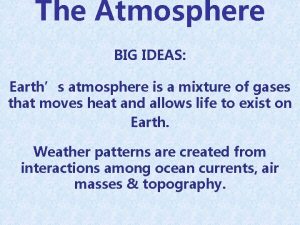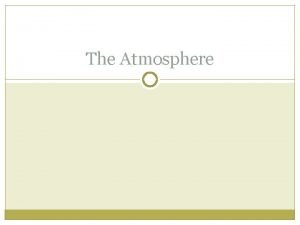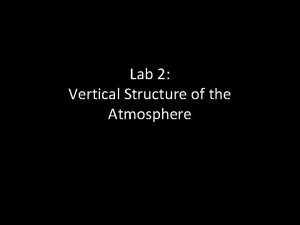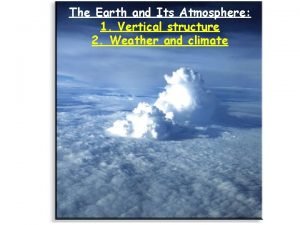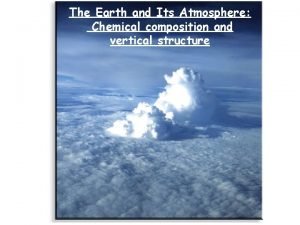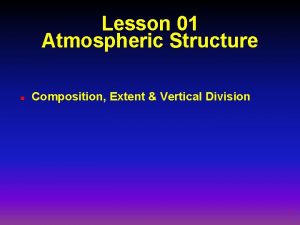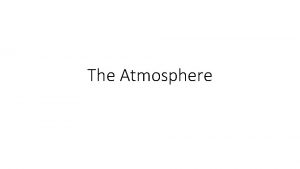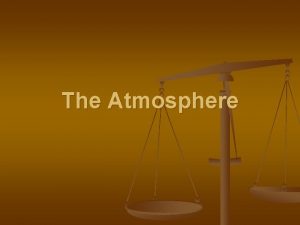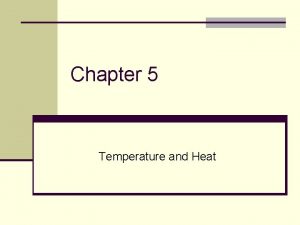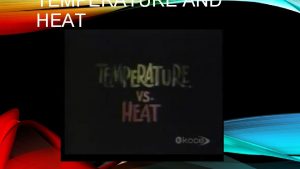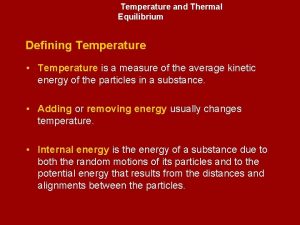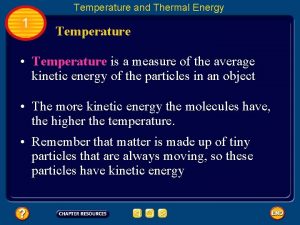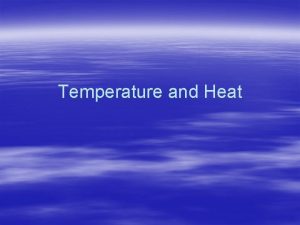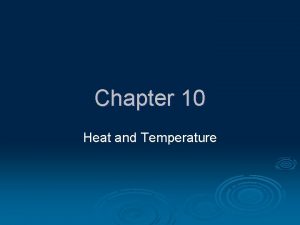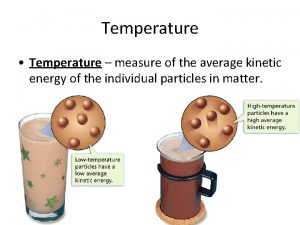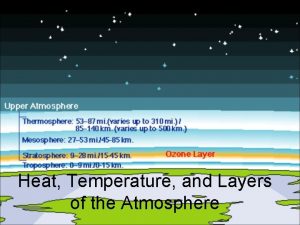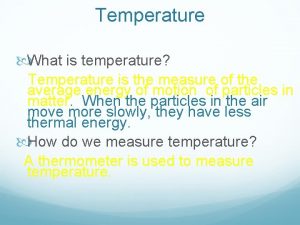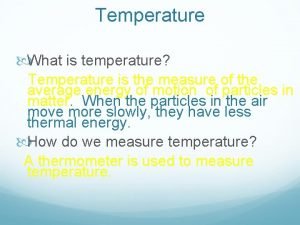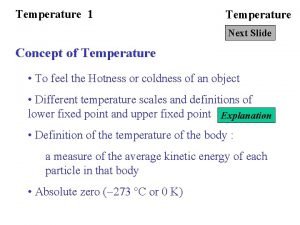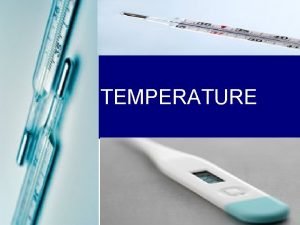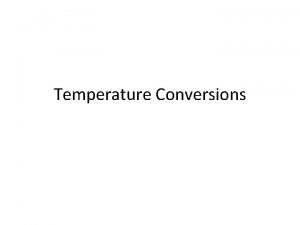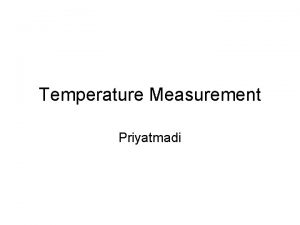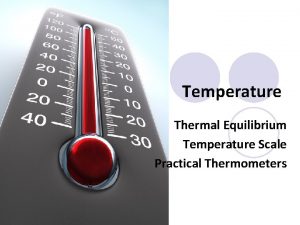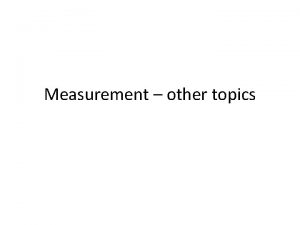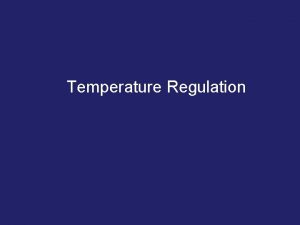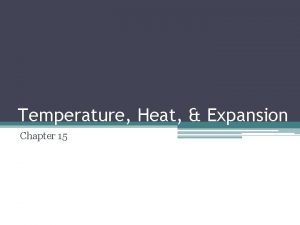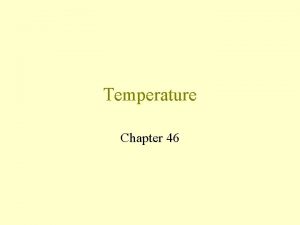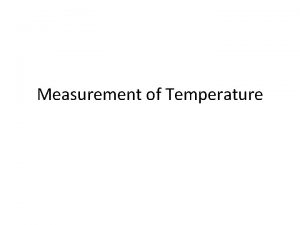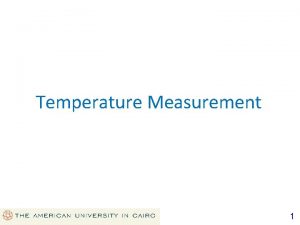THE ATMOSPHERE Structure and Temperature ATMOSPHERE CHARACTERISTICS Most

















































- Slides: 49

THE ATMOSPHERE Structure and Temperature

ATMOSPHERE CHARACTERISTICS • Most important measurable properties • Air Temperature • Humidity • Type of Precipitation • Amount of Precipitation • Air Pressure • Speed of Wind • Direction of Wind

WEATHER VS CLIMATE • Weather • Conditions of the atmosphere at a given time and place • The day to day changes • Climate • Observations of weather that have been collected over many years

COMPOSITION OF THE ATMOSPHERE • Wasn’t always like it is now • 4. 6 billion years ago was made of gases from volcanic eruptions • Oxygen started gathering around 2. 5 billion years ago • Continuously exchanges

MAJOR COMPONENTS OF ATMOSPHERE • Varies from time to time and place to place • 99% Nitrogen and Oxygen • . 93% Argon • . 039% CO 2

VARIABLE COMPONENTS • 1. Water Vapor • Source of all clouds and precipitation • Absorbs heat given off by Earth • Absorbs solar energy

VARIABLE COMPONENTS • 2. Dust Particles • Large particles don’t stay in the air for long • Microscopic particles travel for miles • Sea salts from breaking waves • Fine soil blown into air • Smoke and soot from fires • Pollen and other microorganisms • Ash and dust from volcanic

VARIABLE COMPONENTS • 3. Ozone (O 3) • Concentrated in layer 10 -50 km above Earth’s surface • Near earth we have O 2, but when it rises it absorbs UV radiation and splits into O • Ozone formed when single O atoms collide with O 2 atoms • Ozone layer important to us • Blocks UV rays

HUMAN INFLUENCE • Primary Pollutants • Emitted directly from identifiable source

HUMAN INFLUENCE • Secondary Pollutants • Not emitted directly in air • Form when primary pollutants mix in atmosphere • Sulfur dioxide enters atmosphere • Reacts with oxygen gas • Produces Sulfur Trioxide • Combines with water to produce acid rain

HUMAN INFLUENCE • Secondary Pollutants • Not emitted directly in air • Photochemical reactions • Nitrogen oxides absorb solar radiation • Produces irritating, toxic volatile organic compounds • Known as photochemical smog

PRESSURE CHANGES IN ATMOSPHERE • The higher you go the less air there is to push down on you

TEMPERATURE CHANGES IN ATMOSPHERE • What does this picture show us about temperature changes?

LAYERS OF THE ATMOSPHERE • 1. Troposphere • Tropopause • 2. Stratosphere • Stratopause • 3. Mesosphere • Mesopause • 4. Thermosphere

LAYERS OF THE ATMOSPHERE • 1. Troposphere • Temperature decreases with altitude • All weather occurs here • Made of 99% nitrogen, oxygen, argon and carbon dioxide • Most dense at surface of Earth

LAYERS OF THE ATMOSPHERE • 2. Stratosphere • Temperature is constant up to 20 km then increases (ozone layer) • No wind so air is calm • 19% Atmospheric gases – the rest is ozone

LAYERS OF THE ATMOSPHERE • 3. Mesosphere • Temperature decreases with height • Nitrogen and Oxygen levels are the same as troposphere • There is very little movement but still dense enough to stop meteors

LAYERS OF THE ATMOSPHERE • 4. Thermosphere • Temperatures increase because solar radiation is being absorbed • Very thin • Molecules can travel for miles before hitting one another • We can’t really describe its chemical composition because there are hardly any molecules here

LAYERS OF THE ATMOSPHERE

EARTH-SUN RELATIONSHIPS • All energy for Earth’s weather and climate comes from sun • Earth absorbs less than one twobillionth of energy given off by sun • Still several hundred thousand times more than we need • Sun doesn’t heat everywhere on Earth evenly • Unequal heating causes wind and

EARTH’S MOTIONS • Rotation • Spinning on axis • Happens every 24 hours • Revolution • Orbit around sun • Happens every year • Earth travels 113, 000 km/hr

EARTH’S ORIENTATION • Why is it colder in the winter and warmer in the summer? • Seasonal changes happen because of the tilt of the Earth’s axis • Earth is tilted at 23. 50 from perpendicular • Axis always pointed toward North Star

SUN’S APPARENT PATH • Varies with latitude and season • Angle of noon sun can vary up to 47 degrees in our location • In June when we are pointed toward the sun the rays hit us at a 73. 5 degree angle • In December when we are pointed away it hits at a 26. 5 degree angle

THE SEASONS AND LENGTH OF DAY

SECTION ONE REVIEW • Compare and contrast weather and climate. • Why do seasonal changes occur? • How much of the Earth’s atmosphere is located below 5. 6 kilometers? • How do ozone molecules form? • In which layers of the atmosphere does temperature increase with increasing height? • Explain what would happen to air temperatures in the troposphere if carbon dioxide were removed from air.

HEATING THE ATMOSPHERE • Heat and temperature are two different things • Heat is the energy transferred from one object to another because of a difference in their temperatures • Temperature is a measure of the average kinetic energy of the atoms or molecules of a substance • If energy is added to molecules they move faster and the temperature

WAYS TO TRANSFER ENERGY • 1. Conduction • Transfer of heat through matter by molecular activity • Molecules are close to one another and when one gets excited it hits the one next to it which also gets excited • Like a metal spoon in a hot pot

WAYS TO TRANSFER ENERGY • 2. Convection • Transfer of heat by mass movement or circulation within a substance • Like a lava lamp or hot air balloon • Sun warms objects, air around those objects gets heated by conduction then warm air rises

WAYS TO TRANSFER ENERGY • 3. Radiation • Travels through vacuum of space • All objects, no matter what their temperature, emit radiant energy • Hotter objects radiate more total energy than colder objects • The hottest radiating bodies produce the shortest wavelengths • Objects that are good absorbers of radiation are good emitters too • Atmosphere doesn’t absorb all wavelengths-

WAYS TO TRANSFER ENERGY

ELECTROMAGNETIC WAVES • These waves move at 300, 000 km/second through space • Our atmosphere doesn’t slow them down too much • Waves move out from source like a pebble hitting water

ELECTROMAGNETIC WAVES RAINBOW IS ALWAYS IN SAME ORDER AS ELECTROMAGNETIC SPECTRUM DOUBLE RAINBOW IS REVERSED

WHAT HAPPENS TO RADIATION? • 1. Absorbed • Energy added and temperature increases • 2. Transmitted • Energy passes through • 3. Reflected • Energy bounces off object

WHAT HAPPENS TO RADIATION?

REFLECTION AND SCATTERING • Reflection • Wave bounces off object with same intensity that it hit object • Scattering • Wave split into large number of weaker waves

SO WHY IS THE SKY BLUE? • The air is full of small dust and gas particles • Light gets scattered in all directions • This is how light reaches underneath a shade tree • Blue has a very short wavelength compared to other colors • It gets scattered the most • Sunrise and Sunset are red/orange because of the angle we see them • They have to pass through a lot of particles • Red and orange are long wavelengths and

ABSORPTION • Water vapor and carbon dioxide are good absorbers • When they absorb energy their temperature rises • Known as Greenhouse Effect • This is actually a good thing • We’d be really cold without it • Different from Global Warming • This increase is caused or influenced by

PHOTOSYNTHESIS • Small amount of energy not absorbed and then reradiated • Chlorophyll in plants absorb this energy and use it to make their own type of energy • So the sun is the main source for all energy on Earth

SECTION 2 REVIEW • How are heat and temperature related? • What are three ways heat is transferred? • What three things happen when solar radiation strikes an object? • How are scattering and reflection different? • Dark objects tend to absorb more radiation than light-colored objects. Explain whether dark objects or light

TEMPERATURE CONTROLS • Any factor that causes temperature to vary from place to place and time to time • Latitude • Differential heating of land water • Altitude • Geographic position • Cloud cover

LAND WATER • Lands heats more rapidly but also cools off more rapidly • Cities near water have less temperature variations

LAND WATER • Northern hemisphere • 61% land • 39% water • Southern hemisphere • 19% land • 81% water

GEOGRAPHIC POSITION • Windward coast • Wind blows from ocean onto shore • Leeward coast • Wind blows from land out to ocean

GEOGRAPHIC POSITION • Mountains can get in the way • Reduces effect of windward location

ALTITUDE • Guayaquil • 12 m above sea level • Quito • 2800 m above sea level

CLOUD COVER AND ALBEDO • Albedo • Fraction of total radiation reflected by any surface • Clouds have high albedo • So does snow • During the day you want clouds to reflect sun away and keep you cool • At night you want clouds to reflect Earth’s heat back upon itself to keep you warm

CLOUD COVER AND ALBEDO

WORLD DISTRIBUTION OF TEMPERATURE • Isotherms • Connect points of equal temperature • Look at World Isotherm Map on page 493 • What effect does latitude have on temperature? • What effect does the distribution of land water have on temperature? • Estimate the latitude range for temperatures between 20 and 25 degrees Celsius in the Northern Hemisphere. • Do you expect the color of the temperature band to change near the equator for the month of January?

SECTION 3 REVIEW • What is a temperature control? • How do the heating of land water differ? • Why is it cooler on a cloudy day? What happens to the radiation from the sun on these days? • Why do some coastal cities experience a moderation of temperature from water, while others do not?
 Difference between curie temperature and neel temperature
Difference between curie temperature and neel temperature Difference between curie temperature and neel temperature
Difference between curie temperature and neel temperature Difference between antiferromagnetism and ferrimagnetism
Difference between antiferromagnetism and ferrimagnetism Atmosphere ideas
Atmosphere ideas Characteristics of the atmosphere
Characteristics of the atmosphere Atmosphere vertical structure
Atmosphere vertical structure Vertical structure of the earth
Vertical structure of the earth Structure of atmosphere diagram
Structure of atmosphere diagram Structure of atmosphere
Structure of atmosphere Structure of atmosphere
Structure of atmosphere Hát kết hợp bộ gõ cơ thể
Hát kết hợp bộ gõ cơ thể Ng-html
Ng-html Bổ thể
Bổ thể Tỉ lệ cơ thể trẻ em
Tỉ lệ cơ thể trẻ em Chó sói
Chó sói Tư thế worm breton là gì
Tư thế worm breton là gì Chúa yêu trần thế alleluia
Chúa yêu trần thế alleluia Môn thể thao bắt đầu bằng từ đua
Môn thể thao bắt đầu bằng từ đua Thế nào là hệ số cao nhất
Thế nào là hệ số cao nhất Các châu lục và đại dương trên thế giới
Các châu lục và đại dương trên thế giới Công thức tính thế năng
Công thức tính thế năng Trời xanh đây là của chúng ta thể thơ
Trời xanh đây là của chúng ta thể thơ Mật thư anh em như thể tay chân
Mật thư anh em như thể tay chân Làm thế nào để 102-1=99
Làm thế nào để 102-1=99 Phản ứng thế ankan
Phản ứng thế ankan Các châu lục và đại dương trên thế giới
Các châu lục và đại dương trên thế giới Thể thơ truyền thống
Thể thơ truyền thống Quá trình desamine hóa có thể tạo ra
Quá trình desamine hóa có thể tạo ra Một số thể thơ truyền thống
Một số thể thơ truyền thống Cái miệng nó xinh thế
Cái miệng nó xinh thế Vẽ hình chiếu vuông góc của vật thể sau
Vẽ hình chiếu vuông góc của vật thể sau Thế nào là sự mỏi cơ
Thế nào là sự mỏi cơ đặc điểm cơ thể của người tối cổ
đặc điểm cơ thể của người tối cổ Thế nào là giọng cùng tên?
Thế nào là giọng cùng tên? Vẽ hình chiếu đứng bằng cạnh của vật thể
Vẽ hình chiếu đứng bằng cạnh của vật thể Tia chieu sa te
Tia chieu sa te Thẻ vin
Thẻ vin đại từ thay thế
đại từ thay thế điện thế nghỉ
điện thế nghỉ Tư thế ngồi viết
Tư thế ngồi viết Diễn thế sinh thái là
Diễn thế sinh thái là Dot
Dot Số nguyên tố là số gì
Số nguyên tố là số gì Tư thế ngồi viết
Tư thế ngồi viết Lời thề hippocrates
Lời thề hippocrates Thiếu nhi thế giới liên hoan
Thiếu nhi thế giới liên hoan ưu thế lai là gì
ưu thế lai là gì Sự nuôi và dạy con của hổ
Sự nuôi và dạy con của hổ Sự nuôi và dạy con của hổ
Sự nuôi và dạy con của hổ Hệ hô hấp
Hệ hô hấp



